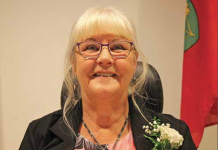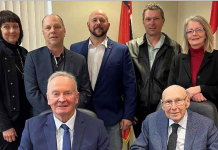As Haliburton County struggles to house moderate-income earners, staffers with the towns of Collingwood and Frontenac County will share success stories at a housing summit Oct. 24 in Minden.
Claire de Souza, the housing development coordinator for the Town of Collingwood, and Joe Gallivan, the director of planning and economic development for the County of Frontenac, are keynote speakers at the Minden Hills Community Centre.
Forum spokesperson, Fay Martin of Places for People, says, “this will be the third time we’ve taken a deep dive into what’s happening in Haliburton County to create the housing people who live and work here need. The day will open and close with from-away guests sharing experiences that have relevance to Haliburton County.” There will be panel discussions on worker housing and densification.
De Souza was hired because Collingwood councillors recognized they had an affordable housing crisis. The town established an affordable housing task force in 2021 and has done a housing needs assessment. The task force remains active today.
De Souza highlighted some of the current, and planned projects, during an interview with The Highlander Oct. 11.
She said they are targeting people with household incomes of $74,000-$109,000, calculating they can afford to buy a home valued at $248,000 to $366,000. Those earning $47,000-$68,000 would be looking at rental rates of $1,200-$1,700-a-month.
“You never see these prices, so that shows us how far away we are from what is actually affordable for folks in the community,” she said. “That is the challenge; how do we get things like that built? What can we do? What can the private sector do? What can the non-market developer group do, or the non-profit development community do, to hit those markers?”
‘Every other township in Ontario can do it’
They responded with a rapid additional residential unit (RARU) program. Part of that is a concierge service. De Souza walks people through the sometimes “technical” planning and building process for affordable housing, or purpose-built rentals. “I try my best to streamline where possible.
After launching the program, she said building permits more than doubled, to 22 from eight.
They also provide pre-approved designs. De Souza explains they put an open call to designers, manufacturers, architecs and builders. Their designs go through town hall and get a stamp of approval with the designs posted on the township website.
“If you’re the average homeowner who’s never done this before, check out these preapproved designs. A lot of the work is done for you. You can contact the designer directly to use the design and it just streamlines the process.”
Another recent move is passing a zoning bylaw amendment. De Souza notes while Bill 23 allows three total units, they’re allowing four on serviced residential properties.
In addition, the town just announced a new seed funding opportunity to help increase the supply of affordable housing.
New or existing housing organizations are now invited to apply to receive up to $25,000. It’s for non-profit or not-for-profits that can develop, own, and operate affordable housing in the community.
Overcoming barriers
The housing development coordinator said she understands the barriers to affordable housing cited by the County of Haliburton and its four lower-tier townships, such as high building costs and a lack of developable land.
“As a municipality, we can only control so much, such as our policies and regulations to make it easier.”
“The private sector cannot build affordable housing without financial support from all levels of government. We’re trying to set up an incentive framework to offer real financial incentives to developers, both non-market and market developers in exchange for affordable housing.” She conceded the challenge is finding the money to create incentives.
As for a lack of land, she calls for innovation and creativity. In the new year, they plan to do a high-level inventory of land that doesn’t meet typical lot size and frontage.
“How can we use smaller lots that haven’t typically been considered? We’re going to go to our development community and ask, ‘what can you do here, using unique construction techniques, different types of builds, modular-style; what can you do that we haven’t thought of before’?
“You have to consider building up rather than building out; higher density and heights, which is always a challenge in smaller, more rural municipalities. You always have to balance that with what the community is prepared for.”
She said that means people need to change their attitudes towards housing and not be so ‘not in my backyard.’
She agreed that dedicating a staff person to housing at a County level may also be key.
“We’re really lucky in Collingwood, our council has really taken the bull by the horns and said ‘we care about housing’. This is something we heard a lot about on the campaign trail. And they’ve really put that effort into creating the position and allocating a budget to housing.
“Every other municipality in Ontario can do it as well. We’re a small urban municipality but we’re taking a lot of initiative, that surprises some municipalities across the province. We have a dedicated staff person, an affordable housing task force, and affordable housing master plan, and we’ve had a budget allocation for the last three years.”





